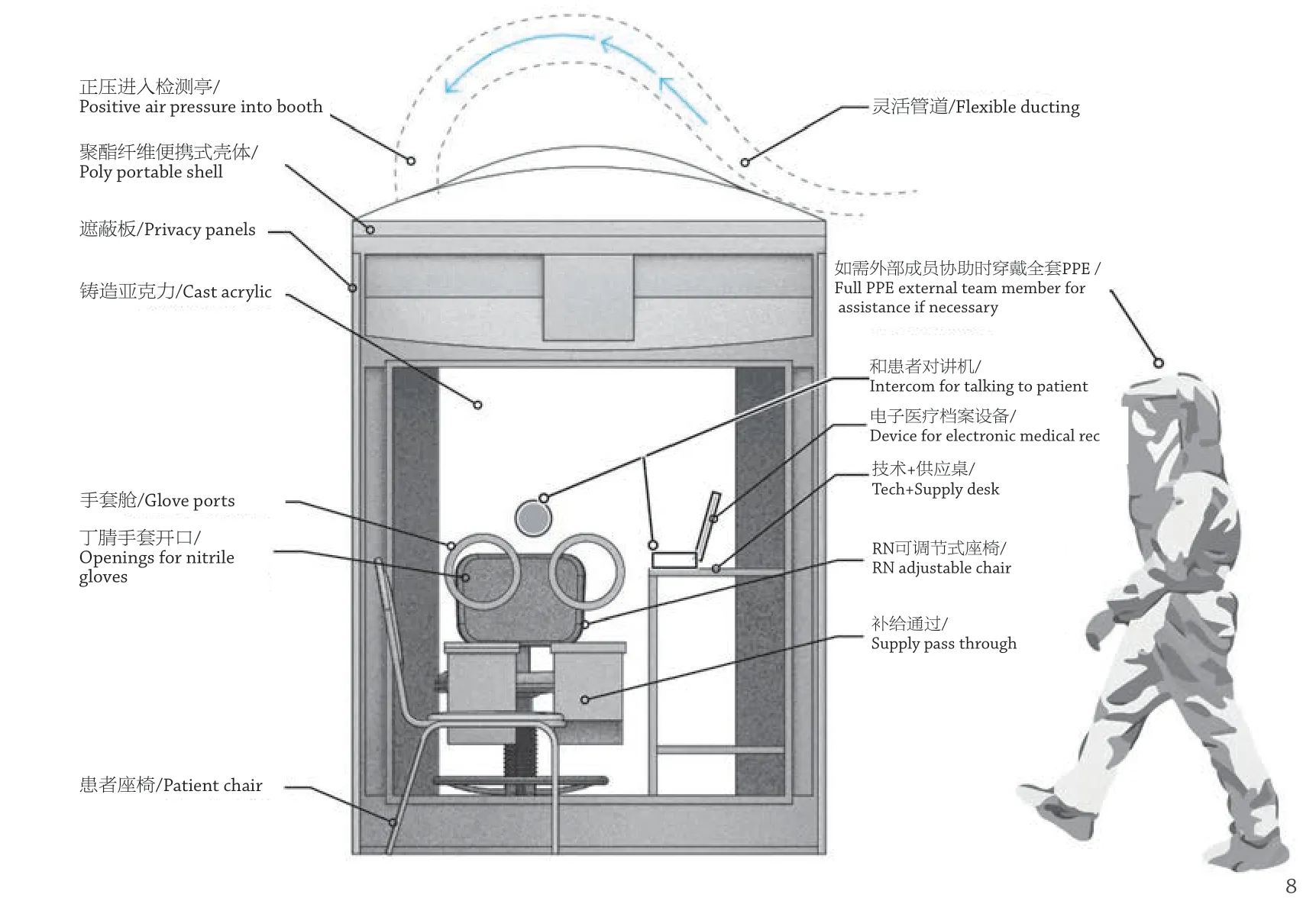可移动检测站建设指南,南卡罗来纳,美国
2020-12-26建筑设计克莱姆森大学建筑学院
建筑设计:克莱姆森大学建筑学院
为了在应对大量涌入的新冠肺炎病例的同时维持医疗设施的安全,位于南卡罗来纳州查尔斯顿的南卡罗来纳州医科大学(MUSC)和克莱姆森大学建筑与社区营造课题组展开了一项设计研究,将病人分流到专门收集样本的分支点。为此设计了一种可移动检测站(PPOD),以提供更经济、安全、便捷、直达式的检测方法。
起初,项目对南卡罗来纳州西阿什利现有的一个由MUSC 管理的免下车式呼吸样本采集点(RSCS)进行了调研。这个采集点具备日采集量约600 个样本的能力。病人从抵达到离开平均耗时10分钟。它被分为3 个区:
红区:高风险。该区包含了所有的病人登记处、样本采集口和通道。
橙区:可能有风险。该区是红绿区之间的过渡,并包含污染区。
绿区:无风险。该区保持无污染状态,包括控制台、设备及其他运行所需装置。
在完成对场地的调研,并对持续发展的疫情进行观察之后,我们认为需要制定一种更便捷的方案。总的来看,免下车的方式可能无法惠及服务不到位和弱势的人群,比如低收入群体、旧城地区居民、老年人和少数族裔。免下车检测点过高的日常运行费用,以及更换患者全套个人防护装备(PPE)的需求造成的供给短缺也是问题。
PPOD 方案意在缓解这些问题。这是一种经过改造的移动式厕所基体,分为标准尺寸和无障碍尺寸,并有为提高视觉性能而用丙烯板改造的病人面板,还有一体化穿过式样本采集门和手套机。医护人员在套上最简式PPE 后从绿区进入PPOD;之后可以坐在舱内,用手套接触坐在外侧(红区)的病人并进行检测。
这种PPOD 具有灵活的移动性,使用更便捷,可适合各种场地,并具备在未来应用的潜力。这种模型因其灵活性而具备不受场地限制的应用方式,并能独立或组合使用。标准尺寸仅限用于检测,而无障碍尺寸可独立用于登记和检测。在经济方面,1.5万美元可以建一处有6 个PPOD 的检测站,另有人员成本。它让人们基本上不再需要PPE,并提高了安全性,因为病人和医护人员是由设施和一体化手套隔开,分别处在红绿区。
其目标是让这种方法和设计长期实施下去,并作为任何医疗机构设计的独立补充,形成病人到站登记的第一条防线,以及病毒检测整体工作的未来环节,让病人安全、有效地接受检测。(尚晋 译)

2 调研阶段:南卡罗来纳州医科大学免下车式呼吸样本采集点官方资料(节选自与南卡罗来纳州医科大学合作创建的文件)/Research phase: MUSC RSCS official documentation (excerpts from document created in collaboration with Medical University of South California)

3 独立可移动检测站/Self-contained PPOD
To maintain safety in medical facilities while coping with a large influx of patients due to the COVID-19 pandemic, MUSC Health and Clemson University Architecture and Community Build in Charleston, South Carolina are working on a design to divert patients to a secondary location for the sole purpose of specimen collection. A Portable Point of Dispensing (PPOD) has been developed to provide a more affordable, safe, and accessible walkup testing method.
Initially, documentation was completed on an existing drive-through Respiratory Specimen Collection Site (RSCS) managed by MUSC in West Ashley, SC. This site had the capability to collect up to approximately 600 samples per day. On average, approximately 10 minutes was spent from the time the patient arrived to the time they departed. The site was structured into three zones:
Red Zone: High hazard. This zone encompassed all patient registration, sample collection, and traffic lanes.
Orange Zone: Possible hazard. This zone was the intermediate between green and red zones and included the decontamination area.
Green Zone: No hazard. This zone was kept contamination free and included control-ops, equipment, and other operational needs.
Upon completing a study of this site and observing the ongoing pandemic it became clear that a more accessible option was needed. In general, drive-through methods can fail to reach underserved and vulnerable populations, such as low-income communities, urban areas, seniors and minorities. Excessive overhead costs to operate the drive-thru testing sites and the need to replace full PPE between patients resulting in dwindling supplies was also an issue.
The proposed PPOD works to mediate these issues. A repurposed portable restroom shell, of either standard or handicap accessible size has it's patient-facing panel modified with an acrylic panel for visibility, with an integrated specimen sample pass-through door and glove ports. Medical personnel enter from the Green Zone into the PPOD after donning minimal PPE, and can sit within the structure and utilise the gloves to reach through and test the patient sitting on the exterior (Red Zone).
The PPOD is flexible in mobility for increased access, in application for various sites, and potential future applications. This model has a site-less approach due to this flexibility, with the ability to be stand-alone or in multiples. The standard size functioning strictly for testing and the accessible size acting as a self-contained option for both registration and testing. Economically, a site of six PPODs can start up for around 15,000 USD with additional costs of "X" for staff. It nearly eliminates the need for PPE and increases safety as patients and personnel are separated between the Red and Green Zones by the structure and integrated gloves themselves.
The goal is to develop this method and design to be implemented permanently as a stand-alone supplement to any healthcare facility design and plan as a first line defense for patient registration upon arriving on-site, as well as becoming the future for virus testing as a whole so that patients can be safely and efficiently tested.

4 可移动检测站现场测试/PPOD testing in field

5 可移动检测站概念平面/PPOD concept plan

6 可移动检测站组装照片/PPOD assembly photos

7 可移动检测站大型场地布局及剖面/PPOD large site layout and section

8 可移动检测站立面/PPOD elevation
项目信息/Credits and Data
地点/Location:美国南卡罗来纳州查尔斯顿/Charleston, South Carolina, USA
客户/Client: Medical University of South Carolina (MUSC)
设计团队/Design Team:
David Pastre/Clemson University School of Architecture Justin Acevedo, Ryan Bing, Jeremy Eaton, Mohamed Fakhry, Luke Gibson, Audrey Hesson, DJ Holmes, Steve Kurtz, Henry Lee III, Andrew Matthews, Claire Mcmanus, William Poynor, Courtney Wolff/Clemson University Architecture + Community Build Students
合作/Collaborators:
Erik Modrzynski, Kimberlyn Whitaker, Mary P. Mauldin/MUSC
Simeon A. Warren/National Centre for Preservation Technology and Training
Paul Mosher/Cluck Design Collaborative
Will Bullock/Will Bullock Creative
施工/Construction:Meadors, Inc. Millwork
顾问/Consultant: Jeff Polutta, Trash Gurl LLC.
材料/Material: 全新/再利用/移动厕所/New/Repurposed Porta-Potty
建筑面积/Floor Area: 标志型–约1.347m2/Standard – Approx. 14.5 ft2, 无障碍型–约2.415 m2/Accessible – Approx. 26 ft2
造价/Cost: Approx. 2500 USD/PPOD with additional costs of "X" for staff on-site
设计周期/Design Period: 2020.01-2020.05(调研记录/Research and Documentation), 2020.05-2020.06(设计组装/Design and Assembly)
建造时间/Construction Period: 2020年夏季/Summer 2020完成时间/Completion Time: 首期6个月且仍在实施中/6 month initial phase; On-going for continued production
绘图/Drawings: Clemson University Architecture + Community Build Students
摄影/Photos: Clemson University Architecture + Community Build Students and Professor
